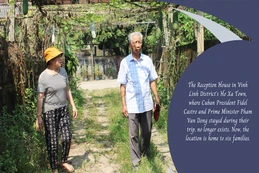Young man breathes life into waste
Miniatures made from garbage have become the favorite things of many people who sought them in admiring the author, Hoang Thanh Tung, 22, a guy who lives in Gio Linh Town, Gio Linh District.

It’s obvious that his lively work has made people fascinated and earned positive responses on TikTok. The million-view clips have brought about orders which become a great source of income for his family.
With meticulous, skillful hands and creativity, Tung has breathed new life into waste.
Known for million-view clips
Tung was known for his favorite clips on house models in the Mekong Delta on TikTok. His clips gained good comments like “What beautiful! It looks real”, “Amazing! You did a good job”, “Your miniatures remind me of my childhood”, and “I want to buy it”, among others.
It’s surprising that Tung has never been to the Mekong Delta. All he knew was via newspapers, videos, and documents on the Internet, but the houses of the region appear to be lively and vivid with typical architecture and become his favorite topic.

He started making miniatures during the Covid-19 pandemic. His passion was initiated by decorating aquariums. During the pandemic, Tung searched for and made the first house models in the Mekong Delta.
“It took me a long time to get started working. I sit down each day to cut, paste, install, and then remove. I snapped a photo and haphazardly posted it on Facebook for good products. Unexpectedly, internet users praised the photos a lot. Even someone ordered from me,” Tung revealed.
“The more I do it, the more passionate I am, and want to stick with this job for a long time,” he added.
The job that the young man initially believed to be for fun ended up bringing him a lot of genuine joy. Immediately after, Tung experimented and made an effort to be original with various themes, including Hoi An, a three-room, old house designed to draw guests. But he is still primarily responsible for creating the model of the Mekong Delta house. Boats, people dressed in bazaar attire, and numerous items like clothing, tables and chairs, bookshelves, water jars, flowerpots, stairs, and shelves all become common sights near these floating wooden houses.

Old cardboard, bamboo, chopsticks, ice cream sticks, and beer cans from the neighborhood are the main materials used. Tung claims that each step in the model-making process requires attention to detail. To preserve the character of the stilt houses on the river, it is necessary to recreate every wooden door, water jar, boat, and canoe parked beneath the wharf. The part where houses are built is the most intricate.
Tung calculated the proportions after having an idea in mind, then cut and arranged wood to create the house“s frame. The cardboard was then cut, and the middle-corrugated layer was used to mimic the look of the corrugated board. He then painted the material and created the final pieces of the house.”Color is the hardest part because it establishes the model"s sincerity and soul. I had to spend a lot of time practicing color mixing online to get the models I have now,” said Tung.

Now that he has mastered it, it only takes him 1-2 days to complete a simple model and about a week for more complex ones. Depending on the size, sophistication, and requirements of customers, each product will be priced at VND1 million (US$43) to VND7 million ($298). Customers are mainly ornamental fish raisers who buy to decorate aquariums. This job brings Tung an income of about VND20 million ($850)/month.
Miniatures with vitality
Tung put a lot of effort into creating models for customers. Despite his laborious work, he had a smile on his face and bright eyes. According to his father Hoang Xuan Chau, he had a great deal of passion for his work. Tung usually stays up late to make the models and does miniatures passionately.
Tung“s attention to detail and creativity for this task may have been influenced in part by the family”s 20-year tradition of producing votive papers. Tung decided to focus on making models, and miniatures, and improving after numerous occasions in which the product was harmed during transportation and the customer canceled the order. “I always try to learn from my mistakes and get better. I am content with my decision and use the money I make from it to support my parents. I”ll make an effort to pursue it, Tung vowed.

Tung“s model is becoming more and more popular with customers as a result of his dedication and inventiveness. In particular, Tung”s products have spread throughout the nation and even internationally, to Japan, Cambodia, and the US, thanks to the million-view clips on TikTok. The model of a small Mekong Delta village with 10 stilt houses, which Tung had been working on for more than two weeks, was recently shipped to the US.
The model“s owner, David Hoang, said:”I know Tung through TikTok. He is pleasant, his work is excellent, and his attention to detail makes me think of my hometown. I"ll encourage more friends to purchase his model.
Tung creates 15 models a month on average. He occasionally produced over 30 models each month, earning tens of millions of dong. Tung shared with us that he would keep creating models of the Mekong Delta“s stilt houses or the ancient town of Hoi An in the future. However, I”ll make an effort to create more miniatures featuring regional landmarks like the Cua Viet and Cua Tung beaches, the Quang Tri Citadel, and the Hien Luong Bridge.
Anyone in the neighborhood who uses beer cans, ice cream sticks, or old chopsticks keeps them and brings them to Tung because they are aware that Tung uses recycled waste to make models. Tung shared with us that he wants to use his products to help people develop the habit of using recycled goods and to protect the environment. Everyone can turn waste into money by simply being creative, Tung said.
Truc Phuong – Linh Pham
0:30:04:2023:20:13 GMT+7








